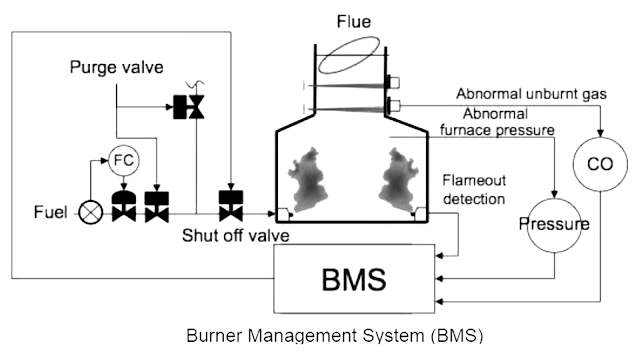Burner Management System
Burner Management System
A burner management system(BMS) is a safety solution that manages a combustion system and is responsible for
Start-up and main flame detection
Control and monitoring
Shutdown sequences
The BMS is considered a safety instrumented system (SIS). In
PLC technology is used, it is often based on 1oo2 (one-out-of-two) or 2oo3d (two-out-of-three diagnostics) logic
BMS interlocks must be implemented with dedicated systems. It can be accomplished by hard-wired relay logic, solid-state logic, or PLCs.
Burner management systems are engineered to provide igniters (pilot) and main flame detection, as well as control and monitoring of burner start-up and shutdown sequences.
This systems can help protect people, combustion process equipment, and surroundings areas in the event of an explosion or hazardous incident.
BMS includes alarm management and operator display. These features help simplify unit operation while reducing start-up time.
Purpose of BMS
- To inhibit startup when unsafe conditions exist.
- To protect against the unsafe operating conditions and admission of improper quantities of fuel to the furnace.
- To provide the operator with status information operator assistance
- To initiate a safe operating condition or shutdown interlock if unsafe condition exists.
- As per NFPA 85, “the BMS is a control system dedicated to boiler furnace safety and operator assistance”.
Hardware Design of BMS (PLC Based)
- Design Features
- Each PLC based BMS should incorporate a number of design techniques which help detect and act upon unsafe failure modes which can occur in any microprocessor based system
- These design features include
- Critical Input Checking
- Critical output channel monitoring
- Electro mechanical master fuel trip relay
- Redundant Watchdog timers
- Low water cut-out monitoring during blow down
- Provision for Multiple fuel firing
- Capped gas input during curtailment
- Changeover from gas to oil at any load
- Simultaneous firing of waste and fossil fuels
- Redundant scanners, change scanner with fuel
- Single or multiple burner applications
- Integration of BMS with SCADA
- For Operators
- Clear written messages to indicate status, required operator interaction, trip/alarm indication
- High visibility of display
- Ease Troubleshooting
- Priority messages
Software Design
3 Main Logic Part to a BMS System
3 fundamental items in BMS are
- States & Transitions – When to move from one to another
- Outputs – Valve Positions defined for each State
- Trips – Including which is active during each State
BMS functions
Prevent firing unless a satisfactory furnace purge has first been completed.
Prohibit start-up of the equipment unless certain permissive interlocks have first been completed.
Monitor and control the correct component sequencing during start-up and shut-down of the equipment.
Conditionally allow the continued operation of the equipment only while certain safety interlocks remaining satisfied.
Provide component condition feedback to the operator and, if so equipped, to the plant control systems and data loggers.
Provide automatic supervision when the equipment is in service and provide means to make a Master Fuel Trip (MFT) should certain unacceptable firing conditions occur.
Execute a MFT upon certain adverse unit operating conditions.
Advantages
- Minimize intervention and shutdown time.
- Recover more easily from process upsets.
- Easier integration of components and systems.
- Time synchronization is not needed.
- Reduce hardware and installation cost by installing one system instead of two.
- Minimize the quantity of spare parts.
- Easier and less expensive engineering and maintenance
- Reduce training requirements and time .
- Improve accessibility
Disadvantages
- Less flexible.
- Two separate systems are easier to manage.
- Separated systems lead to reduced long-term administrative costs.
- If there is a hardware fault, the other systems independency keeps it functional.
Why implement BMS in an SIS (Safety Instrumented System)
- Increased safety
- Increased system availability
- Regulatory compliance
BMS in SIS
Burners, furnaces and boilers are very critical and complex systems.
There is evidence that OEMs and end users who wish to comply with standards (IEC/NFPA), or to meet certain insurance requirements, will have to classify burner management systems as safety instrumented systems, to achieve certification by a third party agency.
In the process industry, a BMS is included in the IEC 61511 definition, although not by direct reference. There is also no exclusionary clause.
BMS are defined as SIS if they contain sensors, a logic solver and a final control element according to IEC 61511.
All safety critical processes must be analyzed and their potential risk determined.
By considering a BMS as a SIS, companies can ensure that these systems are designed, maintained, inspected and tested per both the applicable prescriptive standards (API, NFPA, etc.) as well as the latest SIS performance-based standards (ANSI/ISA, and IEC)

Comments
Post a Comment